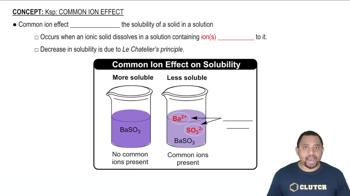Here are the essential concepts you must grasp in order to answer the question correctly.
Solubility Product Constant (Ksp)
The solubility product constant (Ksp) is an equilibrium constant that applies to the solubility of sparingly soluble ionic compounds. It represents the maximum product of the molar concentrations of the ions in a saturated solution at a given temperature. For CoS, Ksp = [Co^2+][S^2-], and if the product of the ion concentrations exceeds Ksp, precipitation occurs.
Recommended video:
Solubility Product Constant
Common Ion Effect
The common ion effect describes the decrease in solubility of an ionic compound when a common ion is added to the solution. In this case, the presence of Co^2+ from Co(NO3)2 can shift the equilibrium of CoS dissolution, potentially leading to precipitation. Understanding this effect is crucial for predicting whether CoS will precipitate under varying conditions.
Recommended video:
pH and Precipitation
The pH of a solution significantly influences the solubility of sulfide compounds like CoS. At lower pH levels, the concentration of H+ ions can suppress the formation of sulfide ions (S^2-), reducing the likelihood of precipitation. Conversely, increasing the pH to 8 with an NH4+-NH3 buffer raises the concentration of S^2-, which may lead to precipitation if the product of ion concentrations exceeds Ksp.
Recommended video:
 Verified step by step guidance
Verified step by step guidance

